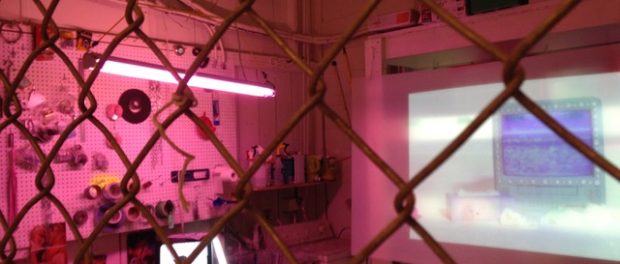Expo Chromatic: Celebrating the Montreal Contemporary Art Scene
Soaring through its 8th edition this year, Chromatic took place at Arsenal and Studio l’Éloi while, once again, offering a multidisciplinary program filled with art and music by local and international artists. The focus of this weeklong festival (May 24 to June 1) is to expose the local art scene while showcasing artistic networks between Montreal and around the world to the public. There were four events to chose from: Chromatic Pro, Chromatic Expo, Chromatic Nuit and Chromatic Kids. Through its programming, the festival sought to form connections with entrepreneurs and professionals, young adults, families and children.
Choosing to experience the opening night of Expo Chromatic, which was held on May 27th at Studio l’Éloi located in the Mile End, I could hear the pounding beats of electronic music before even approaching a kilometer from the red brick building. Or perhaps it was also the fashionable young people walking towards the grimy looking area that I knew I was heading towards the right direction. Upon entering the studio on the fifth floor of the building, crowds of people were dispersed throughout the space. A terasse to oversee the locality while sipping a cocktail after viewing the art of fifty exhibited artists was available to visitors. If you desired to be in a quieter space, a small Lounge Room was provided with an assortment of high-caliber art magazines.

Chromatic. 2017. Photo Stephanie Gagné.
Back to the art, Expo Chromatic divided studio l’Éloi into three rooms, each showcasing various works by various Montreal-based artists working with different mediums: the Dark Room, the Bright Room and the Studio. Topical themes were explored such as feminism and consumerism, the exploration of materials and the artistic medium, and alternative realities.
In the Bright Room, the white walls were emphasized through the vast amount of sunlight shining through the large windows. The focus on the imprisonment of light and color were highlighted through paintings, sculpture and photography. For example, the influences of impressionism through the lens of photography are suggested in Caroline Mauxion’s photographs of white sheets of paper with subtle colored lighting in Passage I and II and François Olivier’s L’arche/auto-portrait, a brightly staged grouping of flowers. Meanwhile, Derrick Piens’s painting, The Serfs, dances between an impressionistic and graffiti aesthetic through the large brushstrokes and fluorescent colors.
By contrast, in the Dark Room, which is in fact dark, are several video installations recreating alternative histories and realities through non-narrative film. The most eye-catching piece was Adrienne Crossman’s Trevi; a huge screen projecting a trippy pixelated video of the baroque-styled Trevi fountain is re-contextualized through digitization. Meanwhile, Lilith’s Alien Ritual reveals new territory through superimposed black-and-white ‘documentary footage’ of ancient landscapes and a non-human female figure moving her body through ritualistic poses.

Chromatic. 2017. Photo Stephanie Gagné.
Perhaps the most interesting room was the Studio, set within the storage space of Studio L’Éloi. Here, contemporary feminist issues were visible, questioning the contentious influences of technology, consumer-capitalism and art history. Composed of school lockers adorned with fifty shades of pink ‘girl products’, Madelyne Beckles’ installation, Theory of the Young Girl discusses the transformative commodification of girls beginning in school through social pressures from peers and the media. Beckles heavily references the theories of Tiqqun who dissects the ‘Young-Girl’ as a figurative term used as both an advocate and a metaphor for the commodification of social life in late capitalist Western society.
Similarly, Monica Reka’s XXX opens the conversation between the private and public spaces of sex within the digital age. The installation is fenced in, creating a boundary between the viewer and the works, positioning the viewer as a voyeur. Appearing as a tool shed with dim pink lighting and with dispersed pornographic photos, a video is projected on a large screen at the center of the room, displaying a TV. Simultaneously criticizing and parodying pornography, the TV showcases a mannequin’s head spinning faster as two pairs of hands, watching the video, pump a water gun just as fast, eventually spraying the TV.
With the opportunity to indulge in Montreal’s contemporary art scene while socializing with like-minded individuals through mellow beats and drinks, Chromatic does a fantastic job of fostering a multifaceted space. The night was thoroughly organized with enthusiastic volunteers at all corners ready to answer any questions about the artworks.
I would highly recommend everyone to attend the festival for its 9th edition next summer.
Keep an eye out for Chromatic’s future editions here.
TAGS: Chromatic, art, music, montreal, festival, arsenal, studio l’éloi, multidisciplinary, mile






